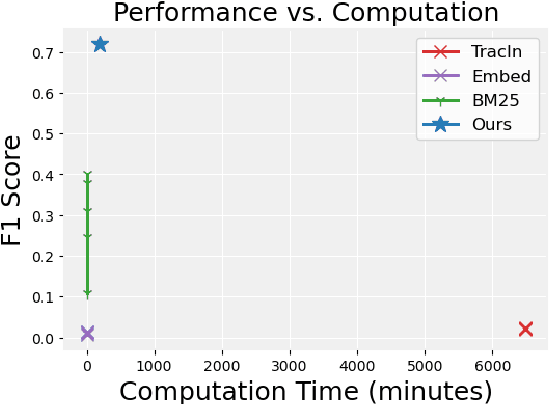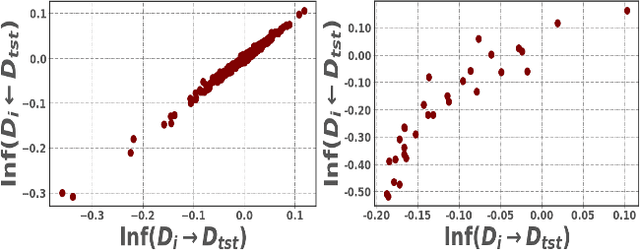Feiyang Kang
AutoScale: Automatic Prediction of Compute-optimal Data Composition for Training LLMs
Jul 29, 2024Abstract:To ensure performance on a diverse set of downstream tasks, LLMs are pretrained via data mixtures over different domains. In this work, we demonstrate that the optimal data composition for a fixed compute budget varies depending on the scale of the training data, suggesting that the common practice of empirically determining an optimal composition using small-scale experiments will not yield the optimal data mixtures when scaling up to the final model. To address this challenge, we propose *AutoScale*, an automated tool that finds a compute-optimal data composition for training at any desired target scale. AutoScale first determines the optimal composition at a small scale using a novel bilevel optimization framework, Direct Data Optimization (*DDO*), and then fits a predictor to estimate the optimal composition at larger scales. The predictor's design is inspired by our theoretical analysis of scaling laws related to data composition, which could be of independent interest. In empirical studies with pre-training 774M Decoder-only LMs (GPT-2 Large) on RedPajama dataset, AutoScale decreases validation perplexity at least 25% faster than any baseline with up to 38% speed up compared to without reweighting, achieving the best overall performance across downstream tasks. On pre-training Encoder-only LMs (BERT) with masked language modeling, DDO is shown to decrease loss on all domains while visibly improving average task performance on GLUE benchmark by 8.7% and on large-scale QA dataset (SQuAD) by 5.9% compared with without reweighting. AutoScale speeds up training by up to 28%. Our codes are open-sourced.
Get more for less: Principled Data Selection for Warming Up Fine-Tuning in LLMs
May 05, 2024



Abstract:This work focuses on leveraging and selecting from vast, unlabeled, open data to pre-fine-tune a pre-trained language model. The goal is to minimize the need for costly domain-specific data for subsequent fine-tuning while achieving desired performance levels. While many data selection algorithms have been designed for small-scale applications, rendering them unsuitable for our context, some emerging methods do cater to language data scales. However, they often prioritize data that aligns with the target distribution. While this strategy may be effective when training a model from scratch, it can yield limited results when the model has already been pre-trained on a different distribution. Differing from prior work, our key idea is to select data that nudges the pre-training distribution closer to the target distribution. We show the optimality of this approach for fine-tuning tasks under certain conditions. We demonstrate the efficacy of our methodology across a diverse array of tasks (NLU, NLG, zero-shot) with models up to 2.7B, showing that it consistently surpasses other selection methods. Moreover, our proposed method is significantly faster than existing techniques, scaling to millions of samples within a single GPU hour. Our code is open-sourced (Code repository: https://anonymous.4open.science/r/DV4LLM-D761/ ). While fine-tuning offers significant potential for enhancing performance across diverse tasks, its associated costs often limit its widespread adoption; with this work, we hope to lay the groundwork for cost-effective fine-tuning, making its benefits more accessible.
FASTTRACK: Fast and Accurate Fact Tracing for LLMs
Apr 22, 2024



Abstract:Fact tracing seeks to identify specific training examples that serve as the knowledge source for a given query. Existing approaches to fact tracing rely on assessing the similarity between each training sample and the query along a certain dimension, such as lexical similarity, gradient, or embedding space. However, these methods fall short of effectively distinguishing between samples that are merely relevant and those that actually provide supportive evidence for the information sought by the query. This limitation often results in suboptimal effectiveness. Moreover, these approaches necessitate the examination of the similarity of individual training points for each query, imposing significant computational demands and creating a substantial barrier for practical applications. This paper introduces FASTTRACK, a novel approach that harnesses the capabilities of Large Language Models (LLMs) to validate supportive evidence for queries and at the same time clusters the training database towards a reduced extent for LLMs to trace facts. Our experiments show that FASTTRACK substantially outperforms existing methods in both accuracy and efficiency, achieving more than 100\% improvement in F1 score over the state-of-the-art methods while being X33 faster than \texttt{TracIn}.
The Mirrored Influence Hypothesis: Efficient Data Influence Estimation by Harnessing Forward Passes
Feb 14, 2024



Abstract:Large-scale black-box models have become ubiquitous across numerous applications. Understanding the influence of individual training data sources on predictions made by these models is crucial for improving their trustworthiness. Current influence estimation techniques involve computing gradients for every training point or repeated training on different subsets. These approaches face obvious computational challenges when scaled up to large datasets and models. In this paper, we introduce and explore the Mirrored Influence Hypothesis, highlighting a reciprocal nature of influence between training and test data. Specifically, it suggests that evaluating the influence of training data on test predictions can be reformulated as an equivalent, yet inverse problem: assessing how the predictions for training samples would be altered if the model were trained on specific test samples. Through both empirical and theoretical validations, we demonstrate the wide applicability of our hypothesis. Inspired by this, we introduce a new method for estimating the influence of training data, which requires calculating gradients for specific test samples, paired with a forward pass for each training point. This approach can capitalize on the common asymmetry in scenarios where the number of test samples under concurrent examination is much smaller than the scale of the training dataset, thus gaining a significant improvement in efficiency compared to existing approaches. We demonstrate the applicability of our method across a range of scenarios, including data attribution in diffusion models, data leakage detection, analysis of memorization, mislabeled data detection, and tracing behavior in language models. Our code will be made available at https://github.com/ruoxi-jia-group/Forward-INF.
Data Acquisition: A New Frontier in Data-centric AI
Nov 22, 2023



Abstract:As Machine Learning (ML) systems continue to grow, the demand for relevant and comprehensive datasets becomes imperative. There is limited study on the challenges of data acquisition due to ad-hoc processes and lack of consistent methodologies. We first present an investigation of current data marketplaces, revealing lack of platforms offering detailed information about datasets, transparent pricing, standardized data formats. With the objective of inciting participation from the data-centric AI community, we then introduce the DAM challenge, a benchmark to model the interaction between the data providers and acquirers. The benchmark was released as a part of DataPerf. Our evaluation of the submitted strategies underlines the need for effective data acquisition strategies in ML.
Performance Scaling via Optimal Transport: Enabling Data Selection from Partially Revealed Sources
Jul 05, 2023



Abstract:Traditionally, data selection has been studied in settings where all samples from prospective sources are fully revealed to a machine learning developer. However, in practical data exchange scenarios, data providers often reveal only a limited subset of samples before an acquisition decision is made. Recently, there have been efforts to fit scaling laws that predict model performance at any size and data source composition using the limited available samples. However, these scaling functions are black-box, computationally expensive to fit, highly susceptible to overfitting, or/and difficult to optimize for data selection. This paper proposes a framework called <projektor>, which predicts model performance and supports data selection decisions based on partial samples of prospective data sources. Our approach distinguishes itself from existing work by introducing a novel *two-stage* performance inference process. In the first stage, we leverage the Optimal Transport distance to predict the model's performance for any data mixture ratio within the range of disclosed data sizes. In the second stage, we extrapolate the performance to larger undisclosed data sizes based on a novel parameter-free mapping technique inspired by neural scaling laws. We further derive an efficient gradient-based method to select data sources based on the projected model performance. Evaluation over a diverse range of applications demonstrates that <projektor> significantly improves existing performance scaling approaches in terms of both the accuracy of performance inference and the computation costs associated with constructing the performance predictor. Also, <projektor> outperforms by a wide margin in data selection effectiveness compared to a range of other off-the-shelf solutions.
LAVA: Data Valuation without Pre-Specified Learning Algorithms
Apr 28, 2023



Abstract:Traditionally, data valuation is posed as a problem of equitably splitting the validation performance of a learning algorithm among the training data. As a result, the calculated data values depend on many design choices of the underlying learning algorithm. However, this dependence is undesirable for many use cases of data valuation, such as setting priorities over different data sources in a data acquisition process and informing pricing mechanisms in a data marketplace. In these scenarios, data needs to be valued before the actual analysis and the choice of the learning algorithm is still undetermined then. Another side-effect of the dependence is that to assess the value of individual points, one needs to re-run the learning algorithm with and without a point, which incurs a large computation burden. This work leapfrogs over the current limits of data valuation methods by introducing a new framework that can value training data in a way that is oblivious to the downstream learning algorithm. (1) We develop a proxy for the validation performance associated with a training set based on a non-conventional class-wise Wasserstein distance between the training and the validation set. We show that the distance characterizes the upper bound of the validation performance for any given model under certain Lipschitz conditions. (2) We develop a novel method to value individual data based on the sensitivity analysis of the class-wise Wasserstein distance. Importantly, these values can be directly obtained for free from the output of off-the-shelf optimization solvers when computing the distance. (3) We evaluate our new data valuation framework over various use cases related to detecting low-quality data and show that, surprisingly, the learning-agnostic feature of our framework enables a significant improvement over the state-of-the-art performance while being orders of magnitude faster.
 Add to Chrome
Add to Chrome Add to Firefox
Add to Firefox Add to Edge
Add to Edge